
Gulls, or colloquially seagulls, are seabirds of the family Laridae in the suborder Lari. They are most closely related to the terns and only distantly related to auks, skimmers and even more distantly to waders. Until the 21st century, most gulls were placed in the genus Larus, but that arrangement is now considered polyphyletic, leading to the resurrection of several genera. An older name for gulls is mews, which is cognate with German Möwe, Danish måge, Swedish mås, Dutch meeuw, Norwegian måke and French mouette, and can still be found in certain regional dialects.

Larus is a large genus of gulls with worldwide distribution. The genus name is from Ancient Greek laros (λάῥος) or Latin larus, which appears to have referred to a gull or other large seabird.

The common gull, mew gull or sea mew is a medium-sized gull that breeds in the Palearctic, northern Europe, and northwestern North America. The names "common gull" and "mew gull" may also be used to refer to specifically the European and North American subspecies respectively. Many common gulls migrate further south in winter. There are differing accounts as to how the species acquired its vernacular name.
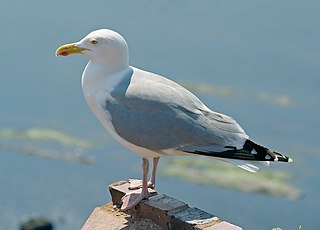
The European herring gull is a large gull, up to 66 cm (26 in) long. One of the best-known of all gulls along the shores of Western Europe, it was once abundant. It breeds across Northern Europe, Western Europe, Central Europe, Eastern Europe, Scandinavia, and the Baltic states. Some European herring gulls, especially those resident in colder areas, migrate further south in winter, but many are permanent residents, e.g. in Ireland, Britain, Iceland, or on the North Sea shores. They have a varied diet, including fish, crustaceans, and dead animals, as well as some plants.

The great black-backed gull, mistakenly called greater black-backed gull by some, is the largest member of the gull family. Described by the Cornell Lab of Ornithology as "the king of the Atlantic waterfront", it is a very aggressive hunter, pirate and scavenger. It breeds on the European and North American coasts and islands of the North Atlantic and is fairly sedentary, though some move farther south or inland to large lakes or reservoirs. The adult great black-backed gull has a white head, neck and underparts, dark grey wings and back, pink legs and yellow bill.

The lesser black-backed gull is a large gull that breeds on the Atlantic coasts of Europe. It is migratory, wintering from the British Isles south to West Africa. It is a regular winter visitor to the east coast of North America, probably from the breeding population in Iceland.

The glaucous gull is a large gull, the second-largest gull in the world. It breeds in Arctic regions of the Northern Hemisphere and winters south to shores of the Holarctic. The genus name is from Latin larus, which appears to have referred to a gull or other large seabird. The specific name hyperboreus is Latin for "northern" from the Ancient Greek Huperboreoi people from the far north "Glaucous" is from Latin glaucus and denotes the grey colour of the gull.

The Iceland gull is a medium-sized gull that breeds in the Arctic regions of Canada and Greenland, but not in Iceland, where it is only seen during winter. The genus name is from Latin larus, which appears to have referred to a gull or other large seabird. The specific name glaucoides denotes its resemblance to Larus glaucus, a synonym of Larus hyperboreus, the glaucous gull; -oides is Ancient Greek and means "resembling".

The yellow-legged gull, sometimes referred to as western yellow-legged gull, is a large gull of Europe, the Middle East and North Africa, which has only recently achieved wide recognition as a distinct species. It was formerly treated as a subspecies of either the Caspian gull L. cachinnans, or more broadly as a subspecies of the herring gull L. argentatus. The genus name is from Latin Larus which appears to have referred to a gull or other large seabird, and the species name honours the German zoologist Karl Michahelles.
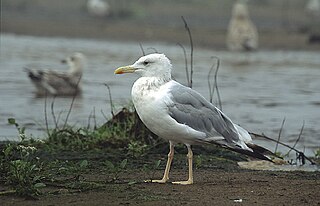
The Caspian gull is a large gull and a member of the herring and lesser black-backed gull complex. The scientific name is from Latin. Larus appears to have referred to a gull or other large seabird, and cachinnans means "laughing", from cachinnare, "to laugh".
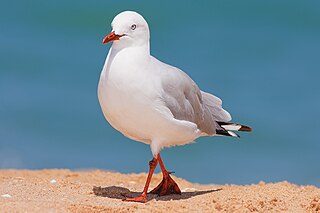
The silver gull is the most common gull of Australia. It has been found throughout the continent, but particularly at or near coastal areas. It is smaller than the Pacific gull, which also lives in Australia.
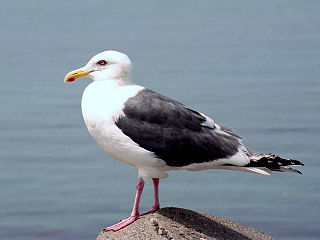
The slaty-backed gull is a large, white-headed gull that breeds on the north-eastern coast of the Palearctic, but travels widely during nonbreeding seasons. It is similar in appearance to the western gull and the glaucous-winged gull. Another alternate name is Pacific gull, though this also applies to a Southern Hemisphere species, L. pacificus. Claims have been made as to its presence throughout North America. as well as the eastern coast of temperate Asia (Palearctic). On 3 November 2012, an individual was spotted in Finland. The species has only been spotted three times before in Europe.

The glaucous-winged gull is a large, white-headed gull. The genus name is from Latin Larus which appears to have referred to a gull or other large seabird. The specific glaucescens is New Latin for "glaucous" from the Ancient Greek, glaukos, denoting the grey color of its wings.
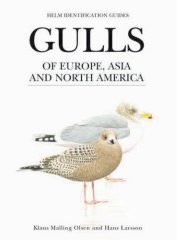
Gulls of Europe, Asia and North America by Klaus Malling Olsen and Hans Larsson is a volume in the Helm Identification Guides series of bird identification books.
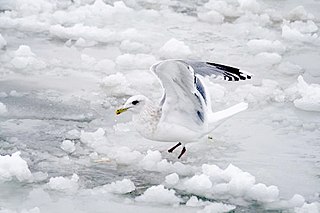
Thayer's gull is a subspecies of the Iceland gull. It is a large gull native to North America that breeds in the Arctic islands of Canada and winters primarily on the Pacific coast, from southern Alaska to the Gulf of California, though there are also wintering populations on the Great Lakes and the upper Mississippi River. The species has occurred as a vagrant to Japan, Denmark, and other parts of western Europe.
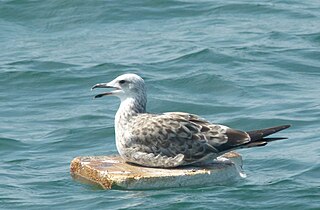
Heuglin's gull or the Siberian gull, is a seabird in the genus Larus. It is sometimes considered as a separate species but is now usually treated as a subspecies of the lesser black-backed gull.
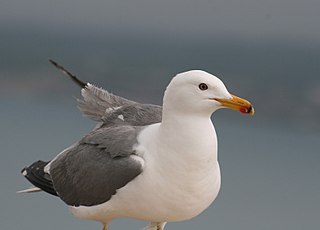
The Armenian gull is a large gull found in the Caucasus and the Middle East. It was formerly classified as a subspecies of the European herring gull, but is now generally considered to be a separate species, although BirdLife International lumps it with the yellow-legged gull.

The Vega gull, East Siberian gull, or East Siberian herring gull is a large gull of the herring gull/lesser black-backed gull complex which breeds in Northeast Asia. Its classification is still controversial and uncertain. It is variously treated as a separate species, as a subspecies of the American herring gull or included with both the American herring gull and European herring gull in L. argentatus. The Mongolian gull, Larus mongolicus, has previously been regarded as a subspecies of the Caspian gull but is now sometimes lumped with the Vega gull.
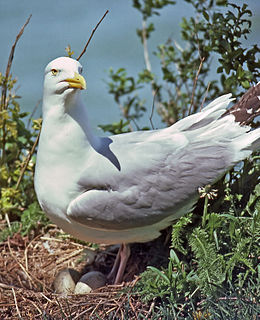
The American herring gull or Smithsonian gull is a large gull that breeds in North America, where it is treated by the American Ornithologists' Union as a subspecies of herring gull.

Gravel Island National Wildlife Refuge is a National Wildlife Refuge located off the Door Peninsula in Wisconsin. Founded in 1913, the refuge consists of two Lake Michigan islands that act as nesting grounds for native bird species. The refuge is part of the Wisconsin Islands Wilderness Area, and as such it is off-limits to the public to preserve the habitat of the islands. It is inhabited by large colonies of shore birds and waterfowl in addition to hosting a pair of great black-backed gulls, one of farthest westward breeding sites of the species.



















